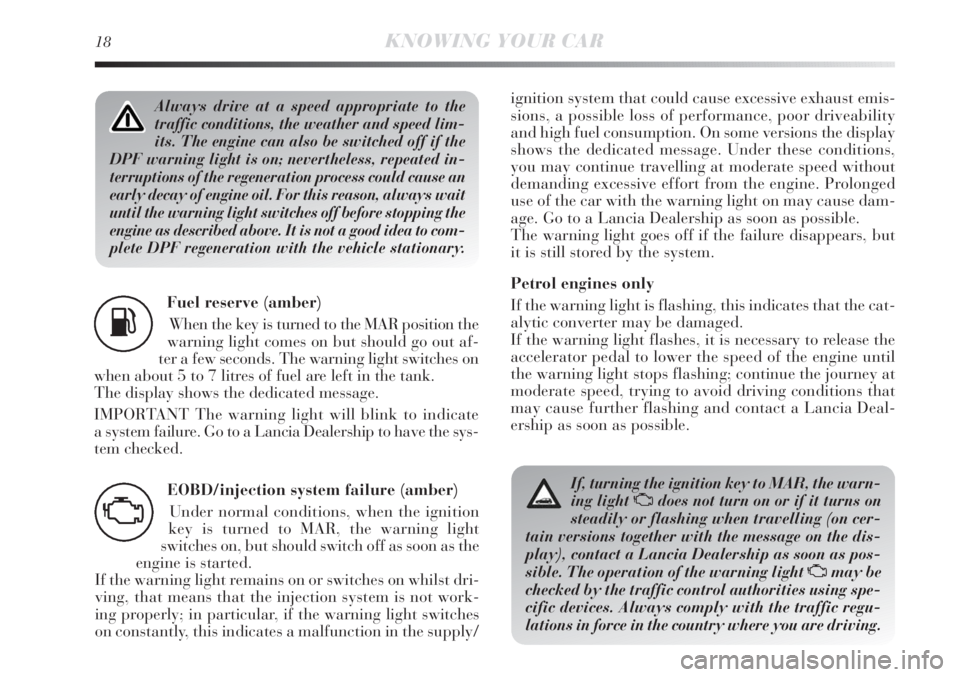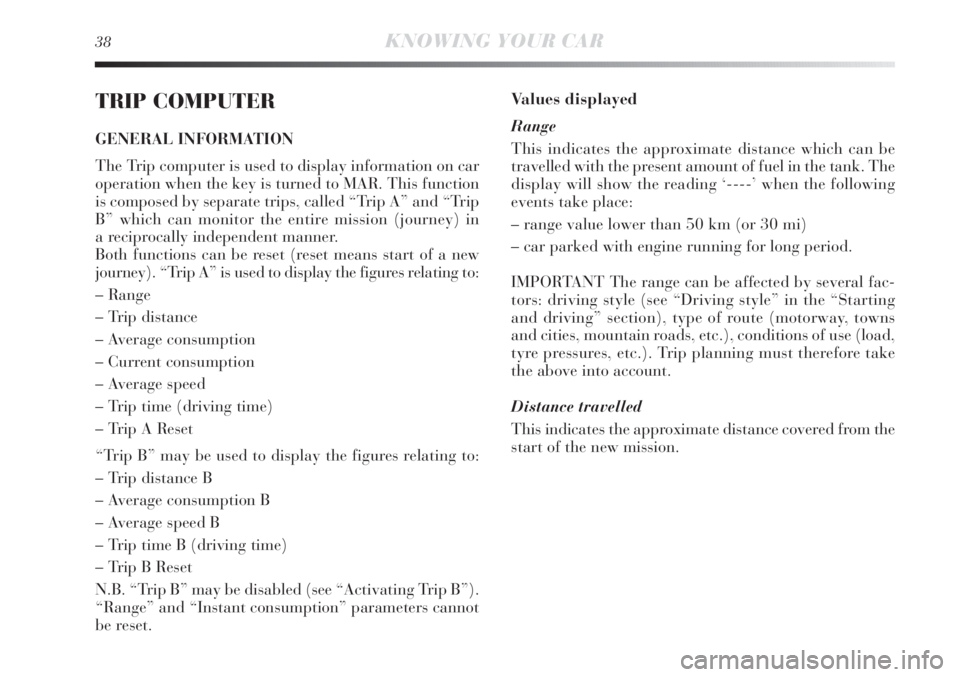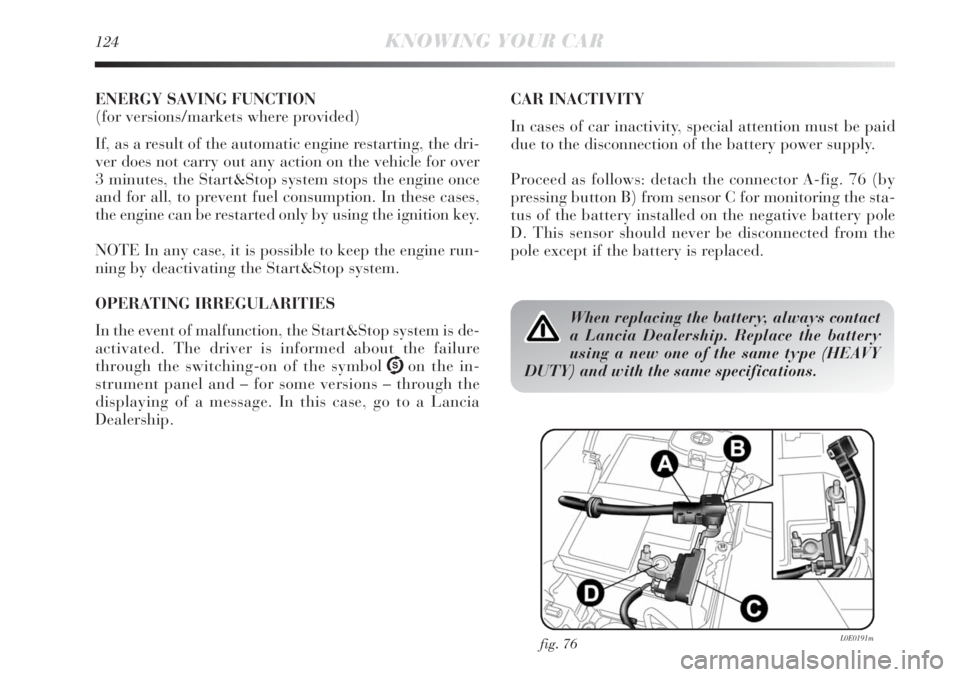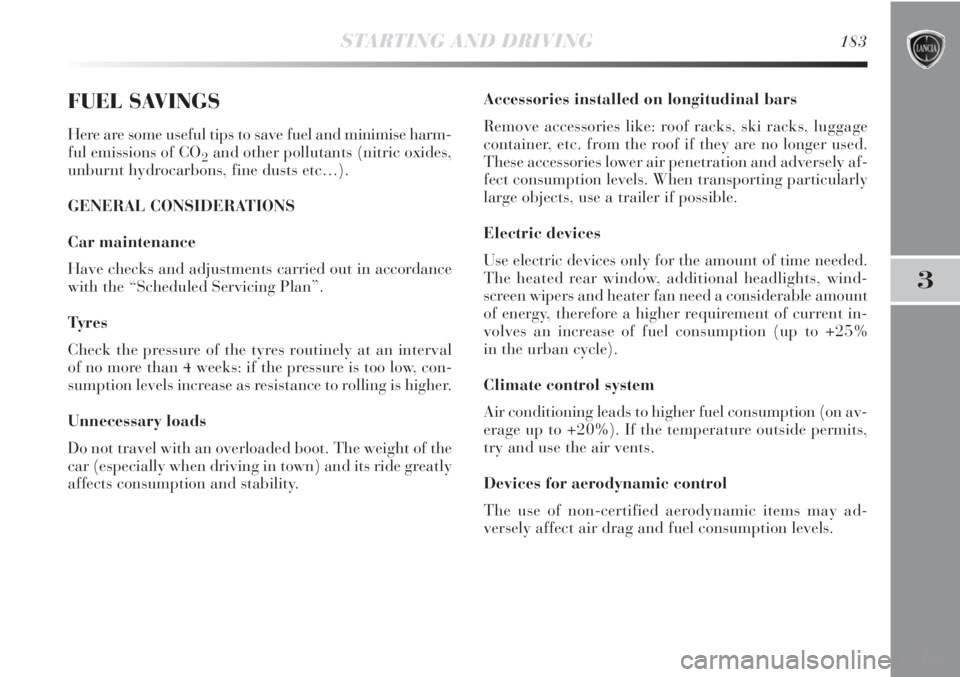fuel consumption Lancia Delta 2012 Owner handbook (in English)
[x] Cancel search | Manufacturer: LANCIA, Model Year: 2012, Model line: Delta, Model: Lancia Delta 2012Pages: 295, PDF Size: 8.29 MB
Page 20 of 295

18KNOWING YOUR CAR
Fuel reserve (amber)
When the key is turned to the MAR position the
warning light comes on but should go out af-
ter a few seconds. The warning light switches on
when about 5 to 7 litres of fuel are left in the tank.
The display shows the dedicated message.
IMPORTANT The warning light will blink to indicate
a system failure. Go to a Lancia Dealership to have the sys-
tem checked.
K
Always drive at a speed appropriate to the
traffic conditions, the weather and speed lim-
its. The engine can also be switched off if the
DPF warning light is on; nevertheless, repeated in-
terruptions of the regeneration process could cause an
early decay of engine oil. For this reason, always wait
until the warning light switches off before stopping the
engine as described above. It is not a good idea to com-
plete DPF regeneration with the vehicle stationary.ignition system that could cause excessive exhaust emis-
sions, a possible loss of performance, poor driveability
and high fuel consumption. On some versions the display
shows the dedicated message. Under these conditions,
you may continue travelling at moderate speed without
demanding excessive effort from the engine. Prolonged
use of the car with the warning light on may cause dam-
age. Go to a Lancia Dealership as soon as possible.
The warning light goes off if the failure disappears, but
it is still stored by the system.
Petrol engines only
If the warning light is flashing, this indicates that the cat-
alytic converter may be damaged.
If the warning light flashes, it is necessary to release the
accelerator pedal to lower the speed of the engine until
the warning light stops flashing; continue the journey at
moderate speed, trying to avoid driving conditions that
may cause further flashing and contact a Lancia Deal-
ership as soon as possible.
EOBD/injection system failure (amber)
Under normal conditions, when the ignition
key is turned to MAR, the warning light
switches on, but should switch off as soon as the
engine is started.
If the warning light remains on or switches on whilst dri-
ving, that means that the injection system is not work-
ing properly; in particular, if the warning light switches
on constantly, this indicates a malfunction in the supply/
U
If, turning the ignition key to MAR, the warn-
ing light Udoes not turn on or if it turns on
steadily or flashing when travelling (on cer-
tain versions together with the message on the dis-
play), contact a Lancia Dealership as soon as pos-
sible. The operation of the warning light Umay be
checked by the traffic control authorities using spe-
cific devices. Always comply with the traffic regu-
lations in force in the country where you are driving.
Page 28 of 295

26KNOWING YOUR CAR
GEAR SHIFT INDICATOR
The “GSI” system (Gear Shift Indicator) advises the dri-
ver to change gear via an indication on the instrument
panel (see fig. 6a).
Shifting when indicated by GSI will help the driver save
fuel.
When the SHIFT UP icon (NSHIFT) is shown on the
display, the GSI is advising the driver to select a higher
gear, while the SHIFT DOWN (OSHIFT) icon suggests
that a lower gear should be engaged.
NOTE The indication on the instrument panel remains
on until the driver changes gear or until the driving con-
ditions return to a situation where a gear change is not
required to reduce consumption.
fig. 6aL0E1025gmfig. 7L0E0005m
CONTROL BUTTONS fig. 7
Õ: To scroll upwards through the displayed menu and
the related options or to increase the displayed value.
SET: press to access the menu and/or go to the next
screen or confirm your choice. Hold down to go
back to the standard screen.
Ô: to scroll downwards through the displayed menu and
the related options or to decrease the displayed value.
Page 35 of 295

1
KNOWING YOUR CAR33
– press the SET button briefly to return to the submenu
screen or hold the button down to return to the main
menu screen without saving;
– press the SET button again for a time to return to the
standard screen or to the main menu according to where
you are in the menu.
Unit of measurement
(Setting the unit of measurement)
With this function is possible to set the unit of measure-
ment in three submenus: “Distance”, “Consumption”
and “Temperature”. To set the required unit proceed
as follows:
– briefly press SET to display the three sub-menus;
– press the
ÕorÔbutton to move between the three sub-
menus;
– once the submenu to be modified has been selected,
briefly press the SET button;
– if the submenu “Distances” is entered: by briefly press-
ing SET the display shows “km” or “mi” depending on
the previous setting;
– press
ÕorÔto make your choice;
– when you select “Consumption”, pressing SET makes
km/l, l/100km or mpg appear on the display depending
on the previous setting;If the distance unit is set to km, you can set the fuel con-
sumption unit to km/l or l/100 km.
If the distance unit is set to mi, fuel consumption is dis-
played in mpg.
– press
ÕorÔto make your choice;
– when you select “Temperature”, pressing SET makes
°C or °F appear on the display depending on the previ-
ous setting;
– press
ÕorÔto make your choice;
When you have made the required settings, briefly press
the SET button to go back to the submenu screen or hold
the button down to go back to the main menu screen
without storing the new settings.
– hold down the SET button again to return to the stan-
dard screen or to the main menu according to where you
are in the menu.
Page 40 of 295

38KNOWING YOUR CAR
TRIP COMPUTER
GENERAL INFORMATION
The Trip computer is used to display information on car
operation when the key is turned to MAR. This function
is composed by separate trips, called “Trip A” and “Trip
B” which can monitor the entire mission (journey) in
a reciprocally independent manner.
Both functions can be reset (reset means start of a new
journey). “Trip A” is used to display the figures relating to:
– Range
– Trip distance
– Average consumption
– Current consumption
– Average speed
– Trip time (driving time)
– Trip A Reset
“Trip B” may be used to display the figures relating to:
– Trip distance B
– Average consumption B
– Average speed B
– Trip time B (driving time)
– Trip B Reset
N.B. “Trip B” may be disabled (see “Activating Trip B”).
“Range” and “Instant consumption” parameters cannot
be reset.Values displayed
Range
This indicates the approximate distance which can be
travelled with the present amount of fuel in the tank. The
display will show the reading ‘----’ when the following
events take place:
– range value lower than 50 km (or 30 mi)
– car parked with engine running for long period.
IMPORTANT The range can be affected by several fac-
tors: driving style (see “Driving style” in the “Starting
and driving” section), type of route (motorway, towns
and cities, mountain roads, etc.), conditions of use (load,
tyre pressures, etc.). Trip planning must therefore take
the above into account.
Distance travelled
This indicates the approximate distance covered from the
start of the new mission.
Page 41 of 295

1
KNOWING YOUR CAR39
Average consumption
This value shows the approximate average fuel con-
sumption from the start of the new journey.
Current consumption
This indicates any change in fuel consumption. The value
is constantly updated. The display will show ‘----’ if the
car is parked with the engine running.
Average speed
This value shows the car’s average speed based on the
overall time elapsed since the start of the new journey.
Journey time
Time elapsed since the start of the new journey.
Trip Reset
This resets the Trip computer settingsTRIP control button fig. 8
The TRIP button is located on the right hand lever. With
the ignition key turned to MAR, this button allows you to
view the previously described parameters and also zero
them to begin a new mission:
– brief press to access the various parameter displays;
– long press to reset and then start a new mission.
fig. 8L0E0007m
Page 126 of 295

124KNOWING YOUR CAR
ENERGY SAVING FUNCTION
(for versions/markets where provided)
If, as a result of the automatic engine restarting, the dri-
ver does not carry out any action on the vehicle for over
3 minutes, the Start&Stop system stops the engine once
and for all, to prevent fuel consumption. In these cases,
the engine can be restarted only by using the ignition key.
NOTE In any case, it is possible to keep the engine run-
ning by deactivating the Start&Stop system.
OPERATING IRREGULARITIES
In the event of malfunction, the Start&Stop system is de-
activated. The driver is informed about the failure
through the switching-on of the symbol Uon the in-
strument panel and – for some versions – through the
displaying of a message. In this case, go to a Lancia
Dealership.CAR INACTIVITY
In cases of car inactivity, special attention must be paid
due to the disconnection of the battery power supply.
Proceed as follows: detach the connector A-fig. 76 (by
pressing button B) from sensor C for monitoring the sta-
tus of the battery installed on the negative battery pole
D. This sensor should never be disconnected from the
pole except if the battery is replaced.
fig. 76L0E0191m
When replacing the battery, always contact
a Lancia Dealership. Replace the battery
using a new one of the same type (HEAVY
DUTY) and with the same specifications.
Page 185 of 295

3
STARTING AND DRIVING183
FUEL SAVINGS
Here are some useful tips to save fuel and minimise harm-
ful emissions of CO
2and other pollutants (nitric oxides,
unburnt hydrocarbons, fine dusts etc…).
GENERAL CONSIDERATIONS
Car maintenance
Have checks and adjustments carried out in accordance
with the “Scheduled Servicing Plan”.
Ty r e s
Check the pressure of the tyres routinely at an interval
of no more than 4 weeks: if the pressure is too low, con-
sumption levels increase as resistance to rolling is higher.
Unnecessary loads
Do not travel with an overloaded boot. The weight of the
car (especially when driving in town) and its ride greatly
affects consumption and stability.Accessories installed on longitudinal bars
Remove accessories like: roof racks, ski racks, luggage
container, etc. from the roof if they are no longer used.
These accessories lower air penetration and adversely af-
fect consumption levels. When transporting particularly
large objects, use a trailer if possible.
Electric devices
Use electric devices only for the amount of time needed.
The heated rear window, additional headlights, wind-
screen wipers and heater fan need a considerable amount
of energy, therefore a higher requirement of current in-
volves an increase of fuel consumption (up to +25%
in the urban cycle).
Climate control system
Air conditioning leads to higher fuel consumption (on av-
erage up to +20%). If the temperature outside permits,
try and use the air vents.
Devices for aerodynamic control
The use of non-certified aerodynamic items may ad-
versely affect air drag and fuel consumption levels.
Page 186 of 295

184STARTING AND DRIVING
DRIVING STYLE
Starting
Do not warm the engine with the car at a standstill or at
idle or high speed: under these conditions the engine
warms up much more slowly, increasing electrical con-
sumption and emissions. It is therefore advisable to move
off immediately, slowly, avoiding high speeds: in this way
the engine will warm faster.
Unnecessary actions
Avoid revving up when at traffic lights or before stopping
the engine. The latter action, like double-declutching, is
completely unnecessary and causes increased fuel con-
sumption and pollution.
Gear selection
As soon as the conditions of the traffic and road allow,
use a higher gear. Using a low gear for faster acceleration
will increase consumption.
In the same way improper use of a high gear increases
consumption, emissions and engine wear.
Max. speed
Fuel consumption considerably increases with speed.
Avoiding unnecessary braking and acceleration, which
cost in terms of both fuel and emissions.Acceleration
Accelerating violently will greatly affect consumption and
emissions: acceleration should be gradual.
CONDITIONS OF USE
Cold starting
Short journeys and frequent cold starts do not allow the
engine to reach optimum operating temperature. This re-
sults in a significant increase in consumption levels (from
+15 to +30% on the urban cycle) and emissions.
Traffic and road conditions
Rather high fuel consumption is caused by heavy traf-
fic, for instance when travelling in a queue with frequent
use of low gears or in large towns with many traffic lights.
Mountain and rough roads also have a negative effect on
fuel consumption.
Traffic hold-ups
During prolonged hold-ups (e.g. level crossings) the en-
gine should be switched off.
Page 259 of 295

6
TECHNICAL SPECIFICATIONS257
Identification data .......................................................... 258
Engine codes – bodywork versions .................................. 260
Engine ............................................................................ 261
Fuel supply system ......................................................... 263
Transmission .................................................................. 264
Brakes ............................................................................. 264
Suspensions .................................................................... 265
Steering ........................................................................... 265
Wheels ............................................................................ 266
Dimensions ..................................................................... 271
Performance ................................................................... 272
Weights ........................................................................... 273
Capacities ....................................................................... 275
Fluids and lubricants ...................................................... 277
Fuel consumption ........................................................... 279
CO
2emissions ................................................................ 280
Page 281 of 295

TECHNICAL SPECIFICATIONS279
6
FUEL CONSUMPTION
The fuel consumption figures given in the table below are
determined on the basis of the type-approval tests laid
down by specific European Directives.
The procedures below are followed for measuring con-
sumption:
❍urban cycle: cold starting followed by driving that
simulates urban use of the car;
❍extra-urban cycle: frequent accelerations in all gears,
simulating extra-urban use of the vehicle: speed varies
between 0 and 120 km/h;
❍combined consumption: calculated with a weighting
of about 37% of urban cycle consumption and about
63% of extra-urban consumption.IMPORTANT The type of route, traffic situations,
weather conditions, driving style, general conditions of
the car, trim level/equipment/accessories, load, climate
control system, roof rack, other situations that affect air
drag may lead to different fuel consumption levels than
those measured.
FUEL CONSUMPTION ACCORDING TO THE CURRENT EUROPEAN DIRECTIVE (litres/100 km)
1.4 Turbo Jet
120 HP1.4 Turbo
Multi Air1.6 Multijet
105 HP1.6 Multijet
115 HP/120 HP
1.9 Twin Turbo
Multijet2.0 Multijet
Urban8.17.35.87.36.7
Extra-urban5.24.84.04.74.2
6.35.74.75.75.1Combined5.7
3.9
4.6